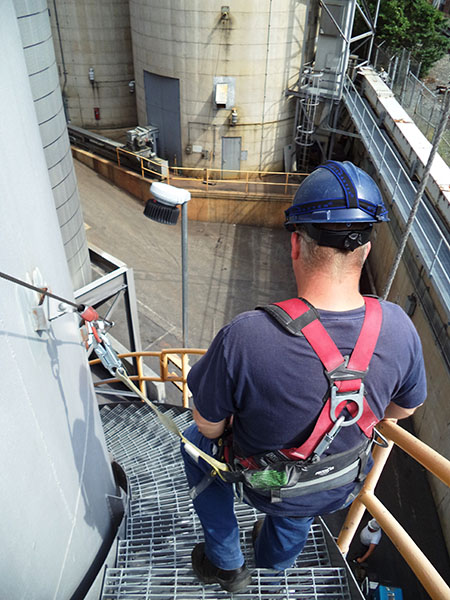What is Fall Protection? Fall Protection is a system that is designed to protect personnel from the risk of falls when working at elevated heights.
What is Fall Prevention? Fall Prevention is a structural design that limits a fall to the same level. Some examples are platforms with guardrails, Bucket Trucks or Mobile Elevated Work Platforms.
What is Fall Arrest Equipment? Fall Arrest Equipment is designed to significantly limit injuries in the event of a fall. It is very important that the equipment is selected and worn correctly, someone’s very life could be "hanging on the line"!
Contact the EHS Fall Protection staff at 434.982.4911.
Yes! UVA Fall Protection Policy ID: SEC-024 - Fall Protection.
Also see UVA Facilities Management Fall Protection Program.
Just remember the ABCs.
A is for the Anchor Point. Something has to keep you safely suspended in air! Federal Law requires an Anchor Point that is structurally sound, good for a static force of 5000lbs. Some options are permanent or reusable anchors that can be attached to roof decks or steel beams.
B is for the Body Harness. The harness straps around your chest, buttocks and thighs. Newer fabrics make the webbing stretchable providing for a more comfortable fit. In the event of a fall, you would be suspended upright and intact (with some gray hairs of course)!
C is for the Connecting Device. This connects the Body Harness to the Anchor Point. Generally these are referred to as Shock Absorbing Lanyards, or Self Retractable Lifelines. A very important part of the Connecting Device is the locking snap hook. Locking snap hooks are required by Federal Law to prevent "roll out". Roll out has resulted in fatalities when the snaphook has become disengaged from the Anchor Point.

A Heat Plant maintenance technician demonstrates fall arrest equipment used with the Horizontal Lifeline on the Fly Ash Silo.
UVA Managers and Supervisors have primary responsibility for providing safe working conditions including Fall Protection.
Yes! Environmental Health & Safety can assist you in the evaluation of your MEWP operation to determine what may be the most appropriate fall protection option.
The Lift Equipment Manufacturer’s instructions (i.e. Operator’s Manual) need to be consulted. The instructions will list pertinent information that address personal fall protection. Articulating Boom Lifts require fall protection to prevent the Operator from being catapulted outside of the MEWP. Generally, a Fall Restraint system secures the Authorized Operator to an anchorage installed and identifiable, by the MEWP manufacturer. The restraint system includes the shortest length shock absorbing lanyard feasible that will prevent the person’s center of gravity from reaching the fall hazard. The restraint system can be thought of as tethering the Operator into place.
For additional information on Safety at Heights go to the J. Nigel Ellis website.
Fall Protection Guidelines are available for the Mobile Elevated Work Platform Operator, Personal Fall Arrest Equipment and Inspection and Ladder Safety
EHS provides the following online training modules:
Fall Protection - Fall Arrest Equipment Orientation (log-in)